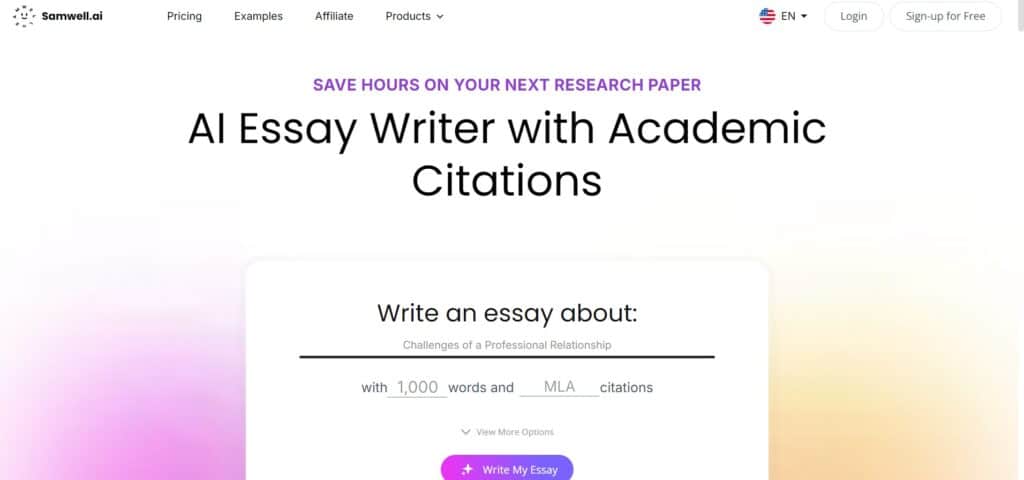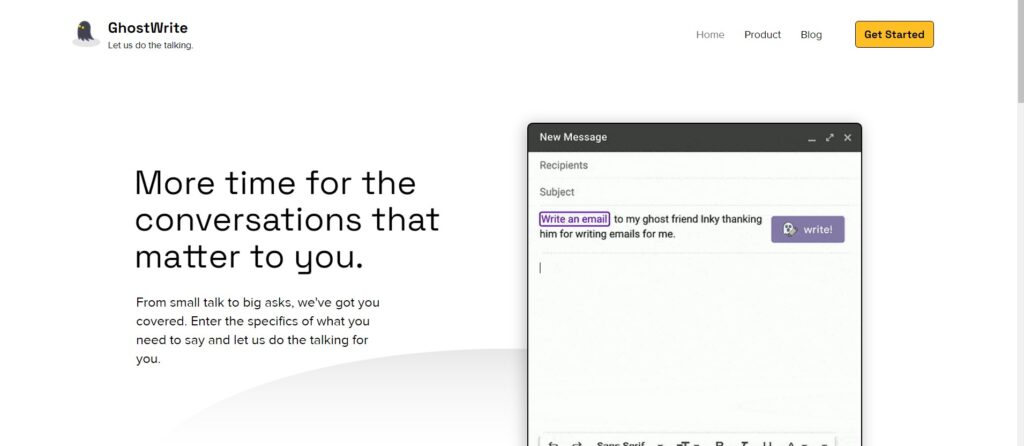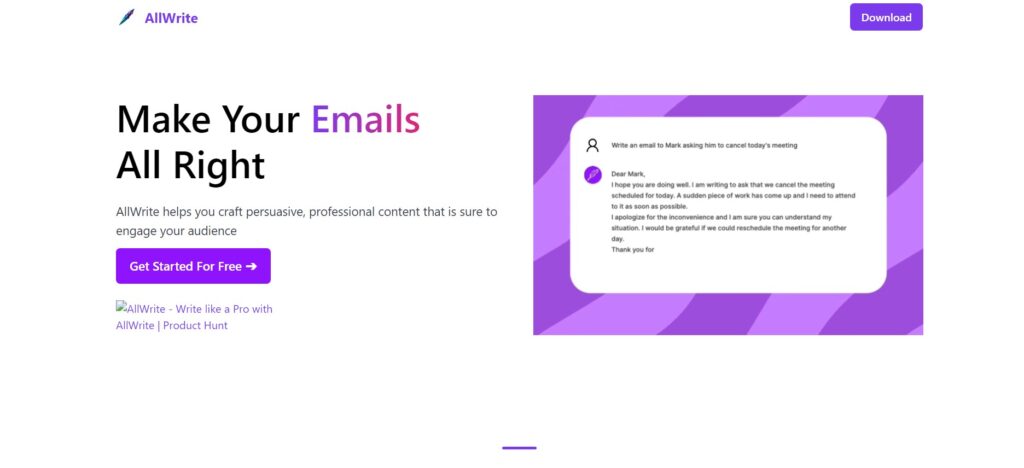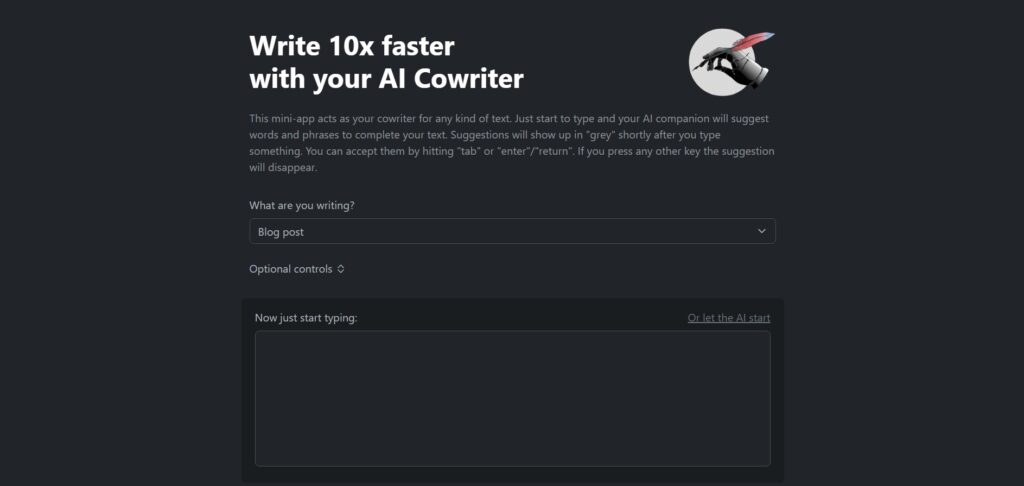8 Powerful AI Writing Assistants – Both Free & Paid
Whether you’re a student, a professional, or a content creator, the demand for clear and engaging writing is constant. Luckily, AI writing assistants have emerged to streamline the writing process.
From generating creative content to providing real-time grammar corrections, these tools are designed to enhance productivity and writing precision.
Best of all, many of these powerful AI writing assistants come with freemium plans, offering a taste of their advanced features without requiring an upfront investment.
Let’s explore some of the best AI writing tools available, both free and paid, that can transform your writing experience.
1. Cowriter
CoWriter is an innovative AI-powered writing assistant designed to help users enhance their writing capabilities, whether for personal, academic, or professional purposes. With a user-friendly interface and a range of tools, CoWriter aims to streamline the writing process, making it easier for users to produce high-quality content efficiently.
Key Features
- Content Generation: CoWriter can generate articles, essays, and creative writing pieces based on user prompts, ensuring diverse content creation.
- Grammar and Style Checking: The platform offers real-time grammar and style suggestions, helping users refine their writing and enhance readability.
- Plagiarism Detection: CoWriter includes a plagiarism checker to ensure that all content is original and free from unintentional copying.
- Customizable Templates: Users can access a variety of templates tailored for different writing tasks, from business reports to social media posts.
- Collaboration Tools: CoWriter supports collaborative writing, allowing multiple users to work on a document simultaneously and share feedback instantly.
Use Cases
- Students: Ideal for crafting essays, research papers, and study materials.
- Professionals: Useful for creating reports, presentations, and business communications.
- Content Creators: A valuable resource for bloggers and marketers needing engaging content quickly.
- Authors: Assists in drafting books, short stories, and other literary works.
Pros and Cons
Pros:
- User-friendly interface, making it accessible for all skill levels.
- Comprehensive tools for writing enhancement and content generation.
- Supports various writing styles and formats.
- Offers a freemium plan for users to try before committing to a paid subscription.
Cons:
- Some advanced features may require a paid plan.
- Users may need to review AI-generated content for quality assurance.
- Limited integrations with other writing tools compared to some competitors.
Pricing
CoWriter offers a freemium model, allowing users to access basic features for free.
For more information, visit CoWriter’s website.
2. Writerightai
WriterightAI is a cutting-edge AI-enhanced writing assistant designed to support users in crafting high-quality content across various formats. Whether you’re a student, professional, or content creator, WriterightAI offers tools to enhance your writing process, making it both efficient and enjoyable.
Key Features
- AI-Powered Content Generation: Quickly generate articles, blog posts, and social media content based on user prompts, tailored to specific topics and tones.
- Advanced Grammar and Style Suggestions: Real-time feedback on grammar, punctuation, and stylistic choices to help users improve their writing.
- SEO Optimisation: Tools to enhance content visibility, including keyword suggestions and optimisation tips for search engines.
- Collaborative Writing: Enables teams to work together seamlessly on documents, with integrated commenting and editing features.
- Customisable Writing Templates: Access a library of templates designed for various writing needs, from academic papers to marketing materials.
Use Cases
- Students: Ideal for drafting essays, reports, and study guides with ease.
- Business Professionals: Useful for creating presentations, proposals, and internal communications.
- Marketers and Bloggers: A resource for generating engaging content that drives traffic and engagement.
- Authors: Supports novelists and writers in developing plots and character dialogues.
Pros and Cons
Pros:
- User-friendly interface that is easy to navigate.
- A wide range of features catering to different writing needs.
- Free plan available, allowing users to explore basic functionalities.
- Strong focus on SEO, beneficial for content creators looking to enhance online visibility.
Cons:
- Advanced features are restricted to paid plans.
- Some users may find the AI-generated content needs further refinement.
- Limited integration with third-party applications compared to some competitors.
Pricing
Paid plans start at $5 per month
For more information, visit WriterightAI’s website.
Continu reading this article. 8 Powerful AI Writing Assistants – Free & Paid
3. Samwell
Samwell is an innovative AI writing assistant that combines advanced technology with user-centric design to help individuals and businesses enhance their writing capabilities. Suitable for various writing tasks, Samwell aims to simplify the content creation process, making it accessible for everyone from students to professionals.
Key Features
- AI-Powered Writing Assistance: Samwell generates high-quality content based on user input, making it easy to create articles, reports, and more.
- Contextual Grammar and Style Checks: Offers real-time suggestions to improve grammar, punctuation, and overall writing style, ensuring polished final outputs.
- Multilingual Support: Users can write in multiple languages, making it a versatile tool for non-native English speakers.
- Plagiarism Detection: Built-in plagiarism checker to ensure originality and integrity of content.
- Customisable Workflows: Users can tailor their writing processes with adjustable settings to suit individual preferences.
Use Cases
- Students: Ideal for composing essays, research papers, and study notes efficiently.
- Content Creators: Perfect for bloggers and marketers looking to generate engaging articles and promotional content quickly.
- Businesses: Useful for creating reports, emails, and corporate communications with a professional touch.
- Writers and Authors: Assists in drafting narratives, character development, and dialogue writing.
Pros and Cons
Pros:
- Intuitive interface that is easy to navigate for all skill levels.
- Comprehensive writing tools that cater to diverse needs.
- Freemium model available, allowing users to explore basic features at no cost.
- Strong support for multilingual writing, broadening its user base.
Cons:
- Some advanced features are only accessible through paid subscriptions.
- Users may need to edit AI-generated content for context and quality.
- Limited integration options with other writing and productivity tools.
Pricing
Paid plans start at $10 per month
For more information, visit Samwell’s website.
You might also like reading these.
4. Ghostwrite
Ghostwriter is Designed for both personal and professional use, Ghostwriter aims to simplify the writing process while delivering high-quality content tailored to various needs.
Key Features
- Content Generation: Ghostwriter can produce articles, blog posts, and social media content based on user prompts, streamlining the writing process.
- Real-Time Editing and Suggestions: Offers immediate feedback on grammar, punctuation, and style, helping users refine their writing on the go.
- SEO Tools: Integrated features to optimise content for search engines, including keyword recommendations and readability analysis.
- Collaboration Features: Supports team collaboration with shared documents and feedback options, making it ideal for group projects.
- Customisable Templates: Users can choose from various templates for different writing tasks, from formal reports to creative storytelling.
Use Cases
- Students: Perfect for crafting essays, research papers, and project reports efficiently.
- Content Marketers: Ideal for generating engaging content for blogs, newsletters, and social media platforms.
- Businesses: Useful for writing professional emails, proposals, and internal communications.
- Creative Writers: Assists authors in developing storylines, character dialogues, and more.
Pros and Cons
Pros:
- User-friendly interface that caters to all writing levels.
- Versatile tools suitable for various writing formats and styles.
- Freemium plan available, allowing users to test basic features without cost.
- Strong focus on SEO, enhancing online visibility for content creators.
Cons:
- Some advanced features are only available through paid subscriptions.
- AI-generated content may require additional editing for tone and context.
- Limited integration with third-party writing tools compared to some competitors.
Pricing
Ghostwriter offers a freemium plan, providing users access to basic functionalities for free. Paid plans start at €10 per month for enhanced features and capabilities.
For more information, visit Ghostwriter’s website.
5. Writesonic
Writesonic is a versatile AI writing assistant designed to help users create high-quality content quickly and efficiently. Suitable for a wide range of writing tasks, from marketing copy to blog posts, Writesonic leverages advanced AI technology to enhance creativity and productivity, making it a valuable tool for individuals and businesses alike.
Key Features
- AI Content Generation: Writesonic can generate articles, advertisements, social media posts, and more based on user-defined prompts, ensuring relevant and engaging content.
- Grammar and Style Enhancement: The platform provides real-time suggestions for grammar, punctuation, and writing style to help users polish their work.
- SEO Optimisation: Built-in tools to assist with keyword research and SEO-friendly content creation, improving visibility on search engines.
- Long-Form Content Generation: Users can create extensive articles and reports effortlessly with the long-form editor, designed for in-depth writing.
- Collaborative Tools: Allows teams to work together on documents, share feedback, and track changes in real time.
Use Cases
- Marketers: Ideal for crafting compelling copy for advertisements, landing pages, and email campaigns.
- Bloggers: Useful for generating engaging blog posts and articles to attract readers.
- Business Professionals: Helps in writing reports, proposals, and internal communications with ease.
- Students: Assists in composing essays and research papers efficiently.
Pros and Cons
Pros:
- User-friendly interface that is easy to navigate for all skill levels.
- Wide range of content types supported, from short ads to long-form articles.
- Freemium plan available, allowing users to test basic features for free.
- Strong focus on SEO, benefiting content creators looking to increase online presence.
Cons:
- Some advanced features require a paid subscription.
- AI-generated content may need further refinement for specific tone and context.
- Occasional inaccuracies in content generation that require user oversight.
Pricing
Paid plans start at $15 per month for additional functionalities and capabilities.
For more information, visit Writesonic’s website.
8 Powerful AI Writing Assistants – Both Free & Paid continues
6. ProWritingAid
ProWritingAid is a comprehensive AI writing assistant designed to help writers of all levels enhance their writing skills. Combining advanced grammar and style checks with in-depth reports, ProWritingAid serves as both a writing tool and an educational resource, making it an ideal choice for authors, students, and professionals alike.
Key Features
- Grammar and Style Checking: ProWritingAid provides thorough grammar, punctuation, and style suggestions, helping users refine their writing in real time.
- Detailed Reports: The platform offers extensive reports on writing style, sentence structure, readability, and overused words, allowing users to track their progress.
- Integration with Other Tools: ProWritingAid seamlessly integrates with popular writing platforms like Microsoft Word, Google Docs, and Scrivener, making it versatile for various writing environments.
- Plagiarism Checker: A built-in feature that ensures content originality by scanning for duplicate text across the web.
- Personalised Writing Coach: Users receive tailored feedback and tips based on their writing habits, promoting continuous improvement.
Use Cases
- Authors and Novelists: Ideal for polishing manuscripts and ensuring narrative consistency.
- Students: Helpful for composing essays and research papers while improving academic writing skills.
- Business Professionals: Useful for drafting reports, proposals, and presentations with a professional tone.
- Content Creators: Assists bloggers and marketers in creating engaging and error-free content.
Pros and Cons
Pros:
- Comprehensive writing analysis that goes beyond basic grammar checks.
- User-friendly interface with a wealth of resources for improvement.
- Flexible pricing options, including a free trial to explore features.
- Strong integration capabilities with various writing tools.
Cons:
- Some users may find the depth of reports overwhelming initially.
- Advanced features are restricted to paid plans.
- Occasional inaccuracies in suggestions that require user discretion.
Pricing
Paid plans start at $10 per year, with options for lifetime access and monthly subscriptions available.
For more information, visit ProWritingAid’s website.
7. AllWrite
AllWrite is an innovative AI writing assistant designed to empower users in creating clear, engaging, and polished content. Whether for academic, professional, or personal writing, AllWrite leverages advanced algorithms to streamline the writing process, making it a versatile tool for a wide audience.
Key Features
- AI-Powered Content Generation: AllWrite can generate a variety of content types, from essays to marketing copy, based on user prompts, saving time and effort.
- Real-Time Grammar and Style Checks: The platform provides instant feedback on grammar, punctuation, and style, ensuring that users produce error-free writing.
- Customisable Writing Templates: Users can choose from a selection of templates tailored for different writing tasks, facilitating a more structured approach.
- Collaboration Tools: AllWrite allows for easy sharing and collaboration, enabling teams to work together on documents and provide feedback seamlessly.
- Analytics and Insights: The tool offers insights into writing patterns and areas for improvement, helping users develop their skills over time.
Use Cases
- Students: Perfect for drafting essays, research papers, and other academic assignments efficiently.
- Professionals: Ideal for creating reports, presentations, and business communications with clarity and professionalism.
- Content Marketers: A valuable resource for generating engaging content for blogs, social media, and email campaigns.
- Writers and Authors: Assists in developing ideas, structuring narratives, and enhancing the overall quality of written works.
Pros and Cons
Pros:
- User-friendly interface suitable for all writing levels.
- Comprehensive features that cater to a wide range of writing needs.
- Freemium plan available, allowing users to access basic functionalities for free.
- Strong collaborative features, ideal for team projects.
Cons:
- Some advanced features require a paid subscription.
- AI-generated content may need further editing for context and nuance.
- Limited integration options with other writing platforms compared to some competitors.
Pricing
Paid plans start at €10 per month for additional functionalities and enhanced capabilities.
For more information, visit AllWrite’s website.
8. AI-cowriter
Al-Cowriter is a robust AI writing assistant that helps users craft high-quality content with ease.
Tailored for a variety of writing needs, from casual blog posts to professional documents, Al-Cowriter leverages advanced AI technology to streamline the writing process and enhance creativity.
Key Features
- AI Content Generation: Al-Cowriter can generate diverse types of content, including articles, social media posts, and marketing copy, based on user prompts.
- Grammar and Style Correction: Offers real-time grammar, punctuation, and style suggestions, ensuring polished and professional writing.
- User-Friendly Interface: The platform is designed for ease of use, making it accessible to writers of all skill levels.
- Custom Writing Templates: Users can choose from a variety of templates tailored to specific writing tasks, facilitating efficient content creation.
- Collaborative Editing Tools: Supports team collaboration, allowing multiple users to work on documents simultaneously and provide feedback.
Use Cases
- Bloggers: Ideal for generating engaging blog posts and articles quickly.
- Businesses: Useful for creating reports, proposals, and marketing materials with a professional touch.
- Students: Assists in composing essays and research papers efficiently.
- Content Creators: A valuable tool for social media managers and marketers to craft compelling content.
Pros and Cons
Pros:
- Intuitive design that is easy to navigate for all users.
- Versatile content generation capabilities that cater to various needs.
- Freemium plan available, allowing users to explore basic features for free.
- Strong collaborative features that enhance teamwork.
Cons:
- Some advanced features are locked behind paid plans.
- AI-generated content may require additional editing for tone and context.
- Limited integration options with third-party applications compared to some competitors.
Pricing
Paid plans start at $12 per month
For more information, visit Al-Cowriter’s website.
These AI writing assistants—offering both free and paid plans—bring efficiency and creativity to your fingertips.
With freemium options available, there’s no better time to explore how these powerful tools can elevate your writing, no matter your needs or budget.

























